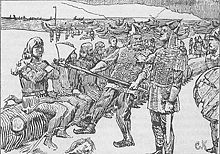Érico (filho de Haquino)
Este artigo carece de caixa informativa ou a usada não é a mais adequada. |

Érico, filho de Haquino (Eiríkr Hákonarson), também conhecido como Érico da Noruega ou Érico de Hlatir[1] (c. 957 ou 963 — c. 1024) foi conde de Lade, líder da Noruega e conde de Nortúmbria.[2] Ele era o filho mais velho bastardo do conde Haakon Sigurdsson. Participou nas batalhas de Hjörungavágr e de Svolder e na conquista da Inglaterra.[2]
Notas
- ↑ Eiríkr é referenciado de diversas formas em fontes medievais e por estudiosos modernos. Ele é mais comumente evidenciado como Yric dux, mas é referenciado nas variações Yric, Yrric, Iric, Eiric ou Eric pelas fontes do século XI em latim e inglês antigo. Em fontes de nórdico antigo é mais comum (com ortografia normalizada) Eiríkr jarl ou Eiríkr jarl Hákonarson, porém às vezes como Eirekr. Historiadores modernos geralmente usam seu patrônimo e se referem a ele como Eiríkr Hákonarson ou alguma variante disso (ex. Eirik/Erik/Eric Hakonarson/Håkonsson/Hakonson) enquanto outros preferem Érico de Hlatir ou Érico de Noruega.
- ↑ a b «Eirik Håkonsson» (em sueco). Enciclopédia Nacional Sueca. Consultado em 23 de junho de 2014
Bibliografia[editar | editar código-fonte]
- Campbell, Alistar (editor and translator) and Simon Keynes (supplementary introduction) (1998). Encomium Emmae Reginae. Cambridge University Press. ISBN 0521626552
- Christiansen, Eric (2002). The Norsemen in the Viking Age. Blackwell Publishing. ISBN 0631216774
- Driscoll, M. J. (editor) (1995). Ágrip af Nóregskonungasǫgum. Viking Society for Northern Research. ISBN 090352127X
- Ekrem, Inger (editor), Lars Boje Mortensen (editor) and Peter Fisher (translator) (2003). Historia Norwegie. Museum Tusculanum Press. ISBN 8772898135
- Faulkes, Anthony (editor) (1978). Two Icelandic Stories : Hreiðars þáttr : Orms þáttr. Viking Society for Northern Research. ISBN 0903521008
- Finlay, Alison (editor and translator) (2004). Fagrskinna, a Catalogue of the Kings of Norway. Brill Academic Publishers. ISBN 9004131728
- Finnur Jónsson (1924). Den oldnorske og oldislandske litteraturs historie. G. E. C. Gad.
- Fox, Denton and Hermann Pálsson (translators) (2001). Grettir's Saga. University of Toronto Press. ISBN 0802061656
- Henry of Huntingdon (translated by Diana Greenway) (2002). The History of the English People, 1000-1154. ISBN 0192840754
- Jackson, Tatiana (Татьяна Николаевна Джаксон). Austr í Görðum: древнерусские топонимы в древнескандинавских источниках. Moscow, Yazyki Slavyanskoi Kultury, 2001. ISBN 5944570229
- Keyser, Rudolph and Carl Rikard Unger (eds.) (1849). Olafs saga hins helga. Feilberg & Landmark.
- Oddr Snorrason (translated by Theodore M. Andersson) (2003). The Saga of Olaf Tryggvason. Cornell University Press. ISBN 0801441498
- Snorri Sturluson (translated by Lee M. Hollander). (1991). Heimskringla : History of the Kings of Norway. University of Texas Press. ISBN 0292730616
- Stenton, Frank M. (2001). Anglo-Saxon England. Oxford University Press. ISBN 0192801392
- Teodorico, o Monge (translated and annotated by David and Ian McDougall with an introduction by Peter Foote) (1998). The Ancient History of the Norwegian Kings. Viking Society for Northern Research. ISBN 0903521407
Érico (filho de Haquino) Nascimento: década de 960 Morte: década de 1020
|
